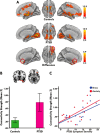Abnormal functional architecture of amygdala-centered networks in adolescent posttraumatic stress disorder
- PMID: 26859310
- PMCID: PMC6867491
- DOI: 10.1002/hbm.23093
Abnormal functional architecture of amygdala-centered networks in adolescent posttraumatic stress disorder
Abstract
Posttraumatic stress disorder (PTSD) is a prevalent, debilitating, and difficult to treat psychiatric disorder. Very little is known of how PTSD affects neuroplasticity in the developing adolescent brain. Whereas multiple lines of research implicate amygdala-centered network dysfunction in the pathophysiology of adult PTSD, no study has yet examined the functional architecture of amygdala subregional networks in adolescent PTSD. Using intrinsic functional connectivity analysis, we investigated functional connectivity of the basolateral (BLA) and centromedial (CMA) amygdala in 19 sexually abused adolescents with PTSD relative to 23 matched controls. Additionally, we examined whether altered amygdala subregional connectivity coincides with abnormal grey matter volume of the amygdaloid complex. Our analysis revealed abnormal amygdalar connectivity and morphology in adolescent PTSD patients. More specifically, PTSD patients showed diminished right BLA connectivity with a cluster including dorsal and ventral portions of the anterior cingulate and medial prefrontal cortices (p < 0.05, corrected). In contrast, PTSD patients showed increased left CMA connectivity with a cluster including the orbitofrontal and subcallosal cortices (p < 0.05, corrected). Critically, these connectivity changes coincided with diminished grey matter volume within BLA and CMA subnuclei (p < 0.05, corrected), with CMA connectivity shifts additionally relating to more severe symptoms of PTSD. These findings provide unique insights into how perturbations in major amygdalar circuits could hamper fear regulation and drive excessive acquisition and expression of fear in PTSD. As such, they represent an important step toward characterizing the neurocircuitry of adolescent PTSD, thereby informing the development of reliable biomarkers and potential therapeutic targets.
Keywords: PTSD; adolescents; amygdala; grey matter; intrinsic functional connectivity.
© 2016 Wiley Periodicals, Inc.
Figures




References
-
- Ackerman PT, Newton JE, McPherson WB, Jones JG, Dykman RA (1998): Prevalence of post traumatic stress disorder and other psychiatric diagnoses in three groups of abused children (sexual, physical, and both). Child Abuse Negl 22:759–774. - PubMed
-
- Amunts K, Kedo O, Kindler M, Pieperhoff P, Mohlberg H, Shah NJ, Habel U, Schneider F, Zilles K (2005): Cytoarchitectonic mapping of the human amygdala, hippocampal region and entorhinal cortex: Intersubject variability and probability maps. Anat Embryol (Berl) 210:343–352. - PubMed
-
- Armstrong JG, Putnam FW, Carlson EB, Libero DZ, Smith SR (1997): Development and validation of a measure of adolescent dissociation: The Adolescent Dissociative Experiences Scale. J Nerv Ment Dis 185:491–497. - PubMed
-
- Baas D, Aleman A, Kahn RS (2004): Lateralization of amygdala activation: A systematic review of functional neuroimaging studies. Brain Res Rev 45:96–103. - PubMed
Publication types
MeSH terms
LinkOut - more resources
Full Text Sources
Other Literature Sources
Medical
Research Materials

